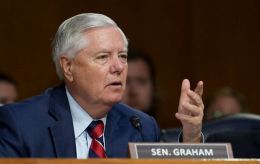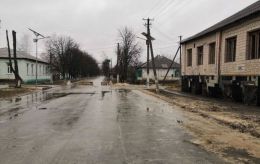Whose is Nagorno-Karabakh? Result of 30-year Armenia-Azerbaijan conflict
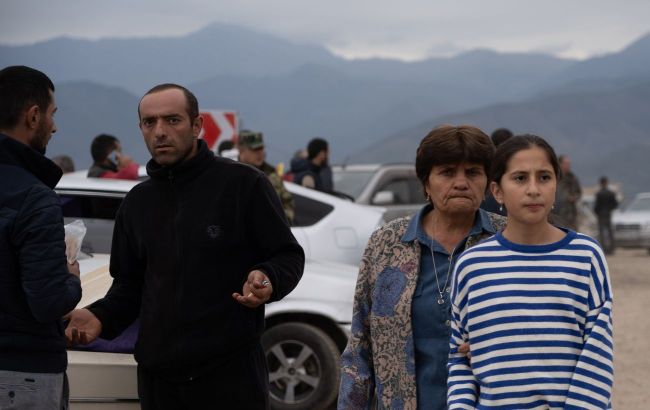 Over 100 thousand Karabakh Armenians have left the region since September 2023 (Getty Images)
Over 100 thousand Karabakh Armenians have left the region since September 2023 (Getty Images)
The self-proclaimed Republic of Nagorno-Karabakh (NKR) is set to cease its existence from January 1, 2024. It is a formality, as almost all Armenians from Karabakh left after Azerbaijan's September operation, and de facto it ceased to exist well before the declared date.
RBC-Ukraine provides details on the aftermath of the recent conflict, the mass exodus of Armenians, and whether the Karabakh issue has fully been resolved.
Sources used in preparing the article: News of Armenia, Armenpress, Caucasian Knot, websites haqqin.az and report.az, the UN mission report, statements by the Prime Minister of Armenia Nikol Pashinyan and the President of Azerbaijan Ilham Aliyev, as well as comments from the expert on South Caucasus affairs at the Polish Institute of International Affairs (Warsaw) Wojciech Wojtasiewicz.
One-day war: How Azerbaijan unraveled the "Karabakh knot"
The dissolution of Nagorno-Karabakh Republic (NKR, Armenian name Republic of Artsakh) became inevitable three years ago. In the early 1990s, with the direct involvement of Armenia, independence was declared, followed by the first war of 1992-1994, in which Azerbaijan suffered defeat. Internationally, the territory was recognized as part of Azerbaijan, and for nearly three decades, Baku dedicated itself to strengthening its economic and military might, declaring the return to Karabakh a national idea.
In late September 2020, the Azerbaijani army launched a massive offensive using heavy machinery, aviation, and drones. The troops advanced rapidly, and within a month and a half, they gained control over several districts with centers in Shushi, Zangilan, Gubadli, and Jabrayil.
The three-party statement by Armenia, Azerbaijan, and Russia on November 9 halted the hostilities. According to it, Armenian forces left the region, Russian "peacekeepers" took control of the Lachin corridor (the only road between Armenia and the remnants of NKR), and Azerbaijan gained control over the districts of Agdam, Kelbajar, and Lachin.
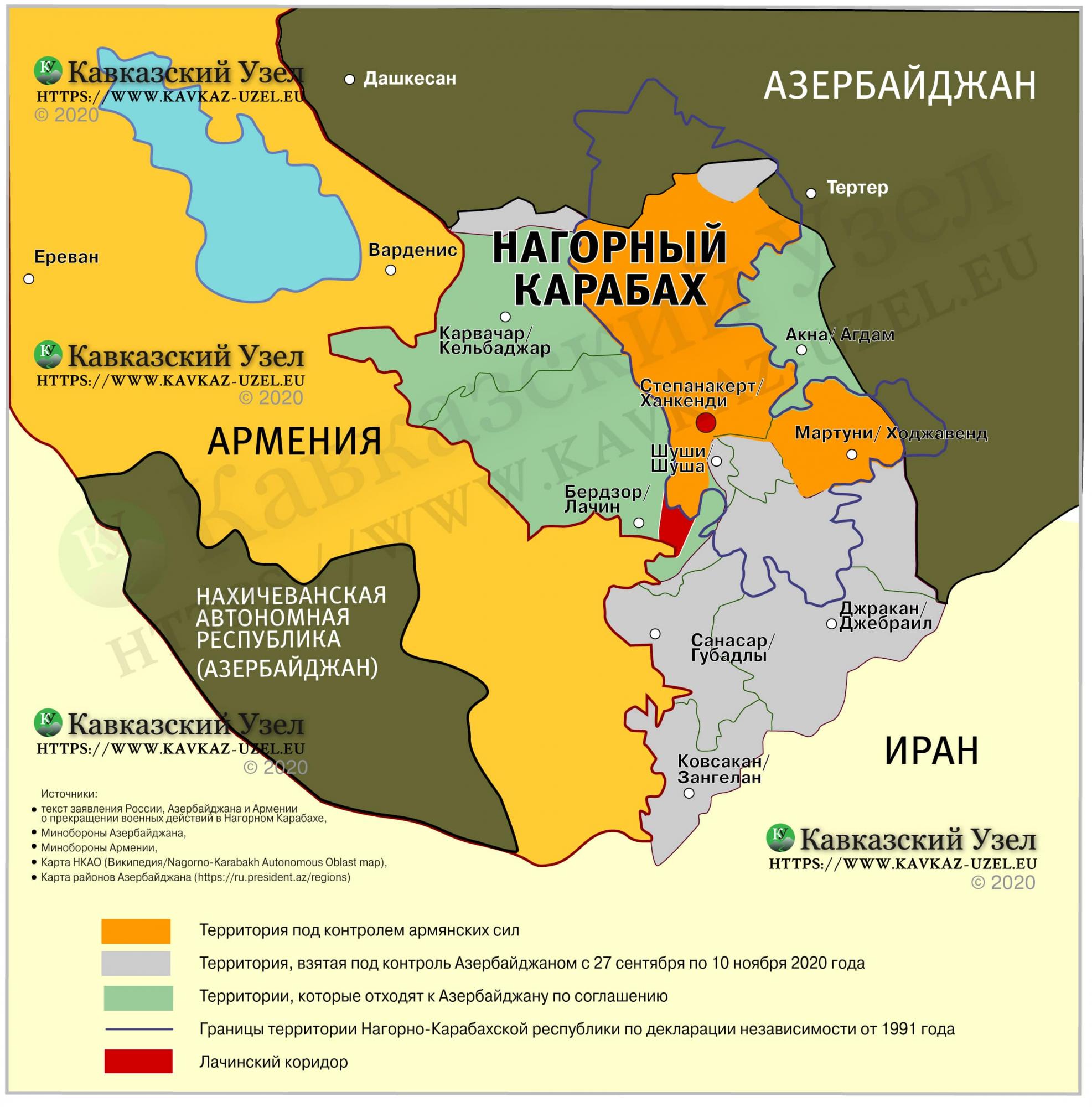
Photo: territorial results of the second Karabakh war in 2020 (kavkaz-uzel.eu)
Since then, Baku and Yerevan have focused on a peaceful agreement, and in 2022, Armenian Prime Minister Nikol Pashinyan publicly spoke about the territorial integrity of Azerbaijan, including Nagorno-Karabakh.
Negotiations progressed slowly. In December of the same year, Azerbaijan blocked the Lachin corridor, and in the spring, they established a checkpoint, completely cutting off Stepanakert from the outside world. In a swift operation on September 19, 2023, which concluded with the republic's capitulation, Azerbaijan implemented its plan.
On September 20, the parties agreed to cease hostilities and disarm Karabakh's military. President Ilham Aliyev of Azerbaijan announced the restoration of sovereignty over Nagorno-Karabakh.
"A new situation is emerging in the region," he said in his address to the nation.
Why didn't Armenia intervene? As Pashinyan said, it was no longer a war between Armenia and Azerbaijan. From his perspective, non-interference was the right decision, as victory was impossible, explained Wojciech Wojtasevich, an expert at the Polish Institute of International Affairs.
"Armenia is weaker than Azerbaijan, and Pashinyan's decision can be called wise. Many thought that Karabakh refugees would be dissatisfied, express anger towards him, society would organize protests, and perhaps a change of government. But they quickly realized that Pashinyan was not to blame, and partly shifted the blame to Russia. Its 'peacekeepers' did not react at all to Azerbaijan's operation; they were passive. Looking at the mood of Armenian society and refugees, almost all of them are against Russia," he explained in an interview with RBC-Ukraine.
The end of the Nagorno-Karabakh Republic: What's wrong with the dissolution decree?
After the capitulation of the Republic of Nagorno-Karabakh, thousands of local residents headed to Armenia. However, the region remained blockaded for several days. The Armenian government prepared to accommodate refugees, demanding the opening of a humanitarian corridor.
By September 23, agreements were reached on the withdrawal of Karabakh military, and the next day, Azerbaijan opened roads through Lachin and Kelbajar. The local population mass evacuated through the Lachin corridor.
In early October, officials, security forces, and the last "president" Samvel Shahramanyan left. Before that, he signed a decree on the dissolution of state institutions. According to the document, the unrecognized NKR ceases to exist from January 1, 2024. While in Armenia, he explained that this decree guaranteed the safety of refugees and disarmed soldiers. By the way, no one touched them on their way to Armenia.
"This became possible as a result of negotiations with the Azerbaijani side," Shahramanyan said.

Photo: NKR "president" Samvel Shahramanyan dissolved the republic, but seems to have changed his mind soon (nankr.am)
As of December, the NKR bodies were functioning on public principles, with the main focus on solving the problems of displaced persons. At the same time, Karabakh activists, politicians, and civic organizations demanded the annulment of the dissolution, and a few days before January 1, confusion arose.
As opposition Republican Party of Armenia deputy Hayk Mamijanyan said, the decree was devoid of legal force from the very beginning. In his opinion, no decree "can dissolve Artsakh, which was created not on paper, but with blood," and its institutions have the function of aiding refugees and preserving cultural heritage.
The Armenian newspaper Zhoghovurd cites Shahramanyan's words, allegedly saying that the dissolution is impossible, but for some reason, the "president" does not talk about its cancellation. Moreover, Zhoghovurd sources say that there is actually a separate decree canceling the dissolution of NKR. But it is unclear why it has not been published yet.
"I don't understand why Armenians are making such statements. Perhaps the first decree was necessary for the evacuation of officials. As we know, the Azerbaijani side did not detain either military or civilians. And to say two or three days before January 1st that it is invalid is at least strange. Probably, this is purely a symbolic gesture to show Azerbaijan: you expelled us, but this is not the end of the story," said expert Wojciech Wojtasiewicz.
Karabakh without Armenians. Why and are there chances of return?
The main outcome of the events of autumn 2023 is the truly massive exodus of Armenians from Karabakh. According to official data, about 120,000 ethnic Armenians lived here. Some of them left after 2020, but the vast majority left after the capitulation of the NKR.
In October, a special UN mission visited the region. According to the report, for example, in Hadrut (Stepanakert), no damage to civilian infrastructure, including hospitals, schools, and residential buildings, was recorded. The Azerbaijani authorities were preparing to restore medical services, all shops were closed, and there were almost no people in the city.
"The team heard from the sources that there are from 50 to 1,000 ethnic Armenians remaining in the Karabakh region... The mission was impressed by the suddenness with which the local population left their homes and the suffering that it presumably caused," the report said.
As the press secretary of the Armenian Prime Minister Nazeli Baghdasaryan reported, by the beginning of October, more than 100,000 displaced people had arrived in the country.
This massive result is quite simple to explain: Karabakh Armenians feared ethnic cleansing.
"We remember that in the early 1990s, Armenians also conducted purges; according to various data, up to a million Azerbaijanis were forced to leave Karabakh and Armenia. And now they are afraid of revenge. Ilham Aliyev offered two options: either leave or stay but accept Azerbaijani citizenship. It can be stated that in reality Nagorno-Karabakh remained without Armenians," explains Wojciech Wojtasiewicz.
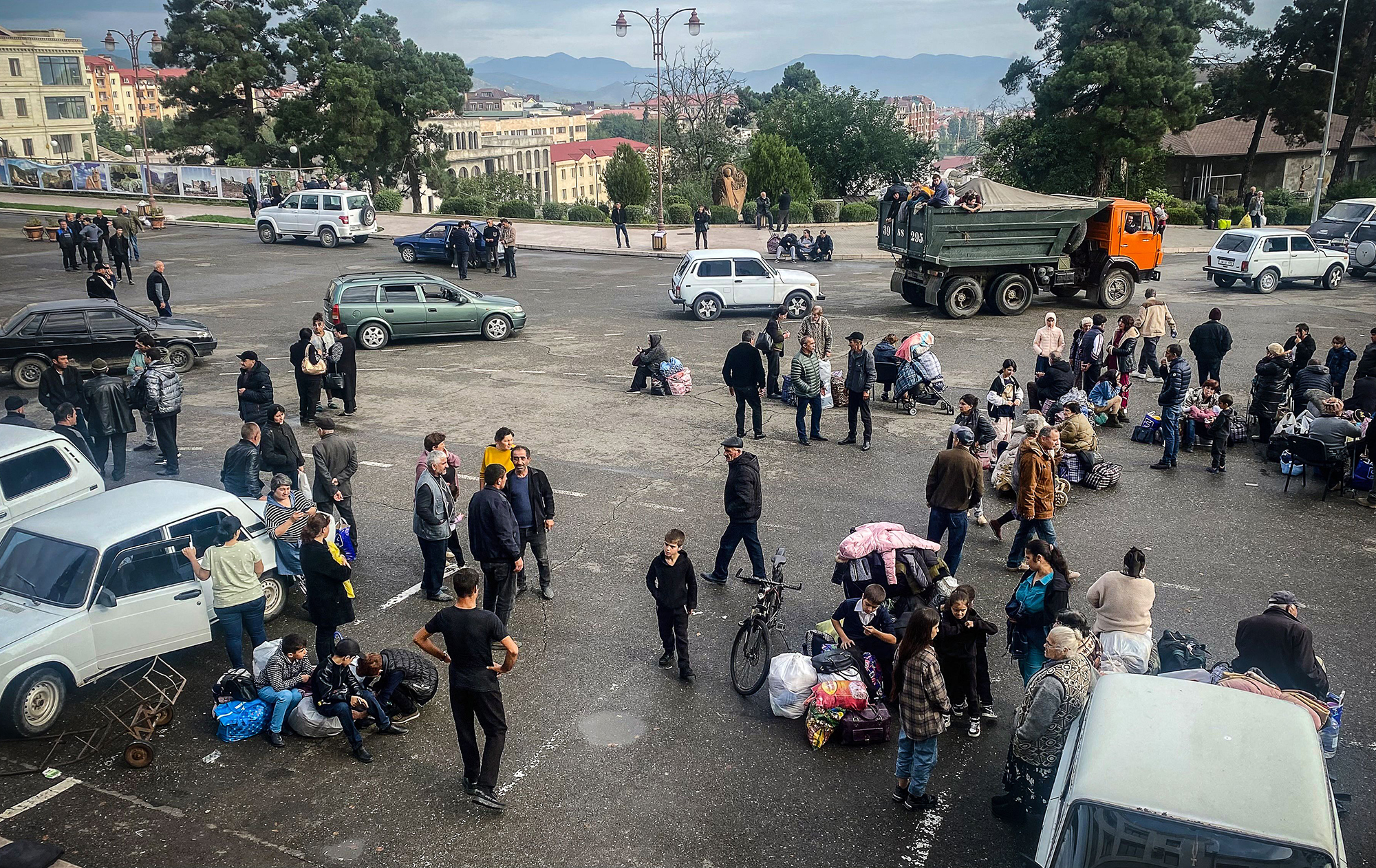
Photo: Karabakh refugees leave the region (Getty Images)
The UN mission did not receive reports of violence against civilians. At this stage, it is difficult to determine whether Karabakh Armenians intend to return, but it is clear that it will require time and efforts from all sides, the report says.
Ilham Aliyev says Armenians can return. But on the condition that they accept Azerbaijani citizenship and forget about the self-proclaimed republic.
"They invented it in their dreams, in their myths," he said in December.
However, it is difficult to imagine that at least in the near future, Karabakh Armenians will return, notes Wojtasiewicz. They have been accepted in Armenia, provided with places to stay, and ensured with payments and pensions. Most likely, for security reasons, the return will not happen anytime soon. For example, former military personnel face arrests because from Azerbaijan's point of view, they are considered terrorists.
"And what will people do in Nagorno-Karabakh? Where will they live, and what will they do for a living? How will they earn a living? I think no one will return. Unless Armenia takes control of it again, but that is not a prospect for the next few years. At most, what it can do is help refugees start a new life," commented the expert in a statement to RBC-Ukraine.
The concerns are not unfounded. Azerbaijan is holding a number of former ministers, including billionaire Ruben Vardanyan, as well as former "presidents" Arayik Harutyunyan, Arkady Gukasyan, and Bako Sahakyan. Some of them have been accused of financing terrorism, involvement in shelling, and torture of prisoners.
"They can be part of negotiations with Armenia for peace. If it takes some actions, they may be released. They have become a tool in Aliyev's hands, and he will use them as it suits him," added Wojtasiewicz.
Armenians to be "replaced" by Azerbaijanis. Baku's return to Karabakh
Currently, Azerbaijan is implementing large projects. Recently, agreements were signed with Turkish companies for the operation of five small hydroelectric power stations in Kelbajar and Lachin regions. Large-scale construction is announced, President Aliyev is opening roads, and local media publish photos of his trips to cities and villages.
"There were even photos from Stepanakert when he enters the administration building, tramples the flag of the NKR, and raises the Azerbaijani flag. All this is to show - Armenians are no longer there, Karabakh is ours, and we have won," the expert said.
The authorities also regularly report on the relocation of Azerbaijanis. For example, in October, several families received keys to apartments in Fuzuli and Lachin - cities that came under control in 2020 and 2022, respectively.

Photo: Azerbaijani President Ilham Aliyev and the Azerbaijani flag in Khankendi (Stepanakert) (president.az)
Migration is taking place in stages, as not all issues related to property rights on these territories have been resolved. As of the end of November, over 3,000 people had moved to Karabakh and East Zangazur regions within the first stage of the "Great Return" program. By the end of 2023, the figure was expected to reach 5,500.
It is expected that this year the return of Azerbaijanis to Shusha and Agdam will begin. In general, the first stage is planned until 2026 and involves the resettlement of 140,000 Azerbaijanis. It is not known exactly how many will be resettled to the former capital of Nagorno-Karabakh - Stepanakert (Hankendi), as the lists are still being compiled.
The main projects are related to the city of Shusha, which Azerbaijan declared the "Cultural Capital of the Turkic World" last year. It will also become the tourist capital of the Organization for Economic Cooperation (including Central Asian and Middle Eastern countries) in 2026, and Shusha aims to become a tourist beacon. In addition to roads and residential buildings, two hotels have been almost completed here, and plans are underway to build a new hospital.
Azerbaijan will spend about $30 million on Karabakh in 2024. The funds are allocated for Hankendi, Agdere (Martakert), Khodjaly (Ivanyan), Khodjavend (Martuni). A victory square and a new educational institution, which will be part of the Karabakh University, will be opened in Hankendi.
Azerbaijan and Armenia: Challenges on the path to peace
The Nagorno-Karabakh issue has been the most critical, but not the sole problem in the relations between Armenia and Azerbaijan. Since the end of autumn, both parties have been sending signals of progress towards a comprehensive peace agreement. Among the steps taken are the first prisoner exchange in a long time and the resumption of border demarcation efforts.
Demarcation remains a sensitive issue. In mid-December, the countries approved a regulation for an intergovernmental commission. The problem lies in President Aliyev's claims of Armenian occupation of eight Azerbaijani villages, countered by Prime Minister Pashinyan asserting territorial claims in response.
"We also have a problem with eight villages because in the same Tavush region, for example, we have territories occupied by Azerbaijan," he said.
Equally contentious is the issue of a road through southern Armenia, connecting Azerbaijan with its exclave Nakhchivan and Türkiye. Baku insists on an extraterritorial status, labeling it the Zangezur Corridor (after the historical name of the region). Armenia disagrees, insisting on maintaining sovereignty over all roads within its territory.

Photo: Armenian Prime Minister Nikol Pashinyan is interested in peace with Azerbaijan, but sets his own red lines (Getty Images)
Yerevan is promoting the "Crossroads of Peace" project, envisioning that all communications will operate under the jurisdiction of the countries they pass through, each conducting its own border and customs control.
However, Azerbaijan is not interested and hints at an alternative route through Iran. The corridor through Armenia's Syunik region is likely on hold, at least until the presidential elections scheduled for February 7, 2024.
The establishment of a transportation route was outlined in the statement that halted the second Karabakh war in 2020, but details remain unclear. Yerevan fears that launching the corridor might lead to a gradual loss of sovereignty over the border with Iran, a territory that Baku considers historically part of Azerbaijan but does not officially question its ownership.
Expert Wojciech Wojtasiewicz suggests that without a compromise, Azerbaijan may view certain sections of the main road from central Armenia to Zangezur as "occupied" and encroach on Armenian lands.
"Azerbaijan wants to control the corridor in terms of tax and customs aspects. There were proposals to involve Russia and Turkey, but the issue of sovereignty is a 'red line' for Yerevan. I constantly read about negotiations, informal contacts, and new proposals. I see no progress, but I hope they reach an agreement," he said in an interview with RBC-Ukraine.
There is a chance that the parties will reach an agreement. According to the Russian news outler Kommersant, a peace deal may be signed shortly after the new year, possibly discussed by Aliyev and Pashinyan at a recent CIS summit in St. Petersburg. However, the strength of the peace remains uncertain, especially after Azerbaijan demonstrated in the Karabakh operation that it prefers force over compromise.
It is too early to speak of a definitive end to the conflict, as all elements of the relationship between the countries have been tied to Karabakh for many years.
"It seems to me that it's just another stage that has ended. In an ideal situation, the territory would become part of Azerbaijan, and Armenians in Karabakh would have political autonomy. I don't believe that under the current authoritarian regime in Baku, a stable peace is possible. It is possible when the parties compromise, and Azerbaijan doesn't interpret concessions as defeat," noted the expert.
The forceful resolution of the Karabakh issue has affected the lives of hundreds of thousands of people. Even if the countries sign a peace agreement, it is unlikely to mark a definitive conclusion.
"For me, it's like the conflict between Israel and Palestine. It has been going on for over 70 years; leaders have signed many agreements over this time, but ultimately, they return to war. That's essentially what we are witnessing now," concluded Wojtasiewicz.
